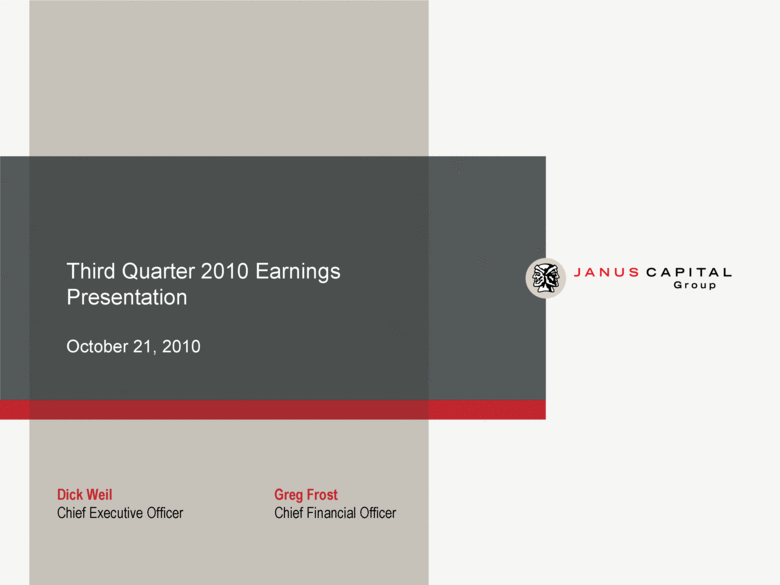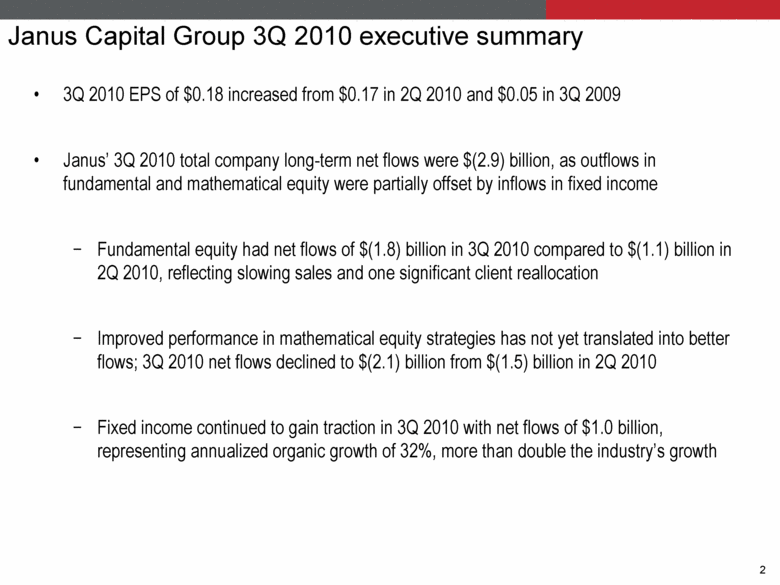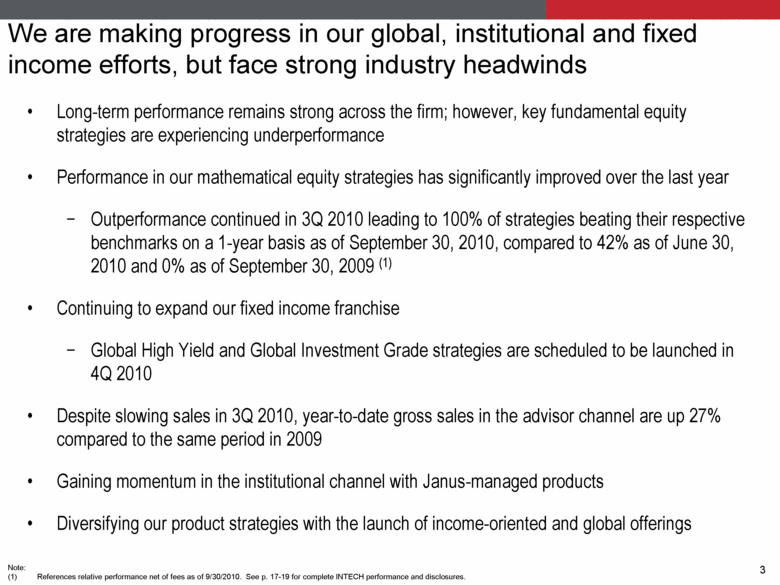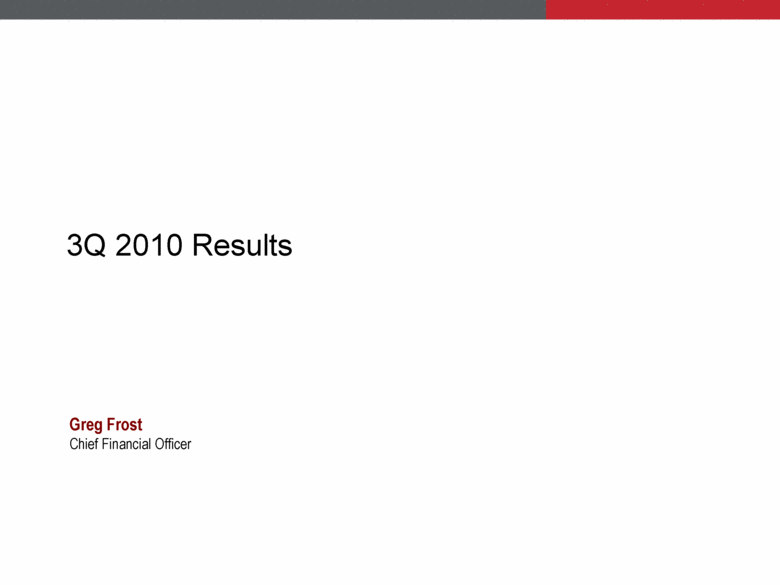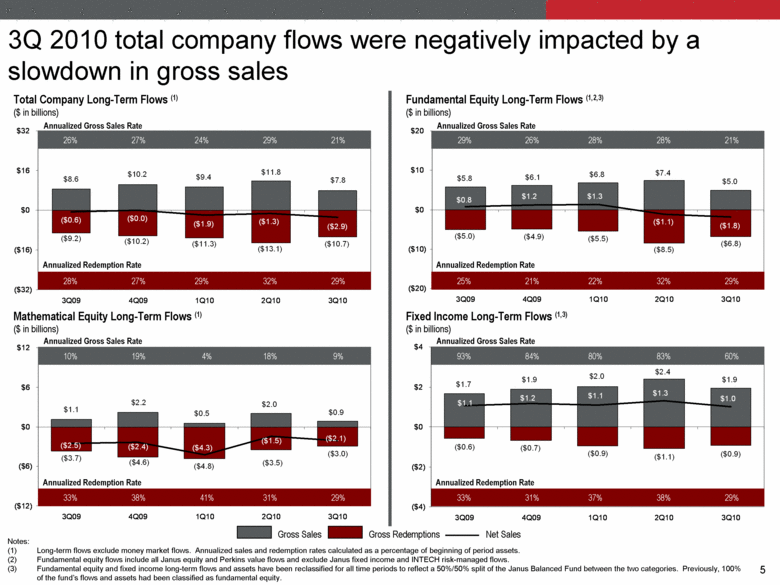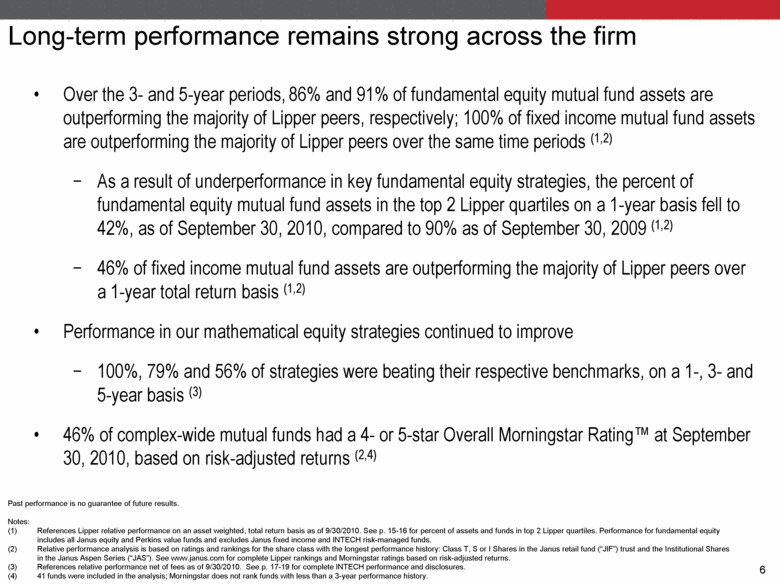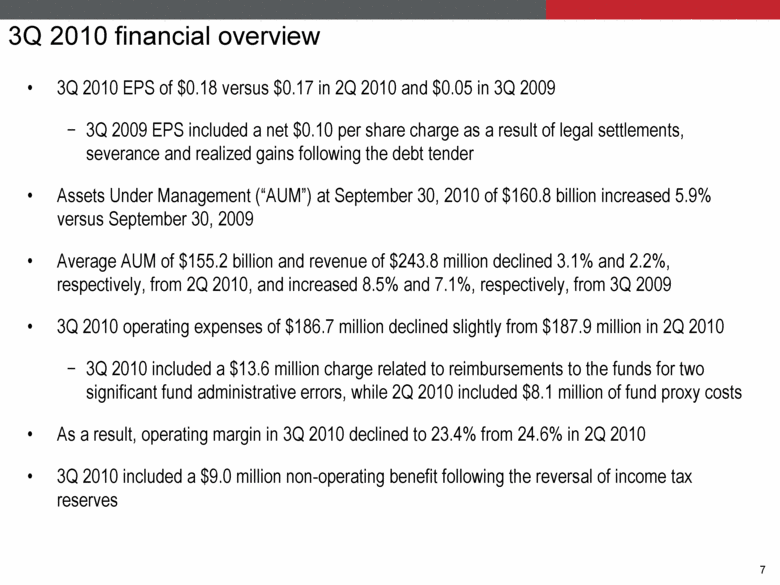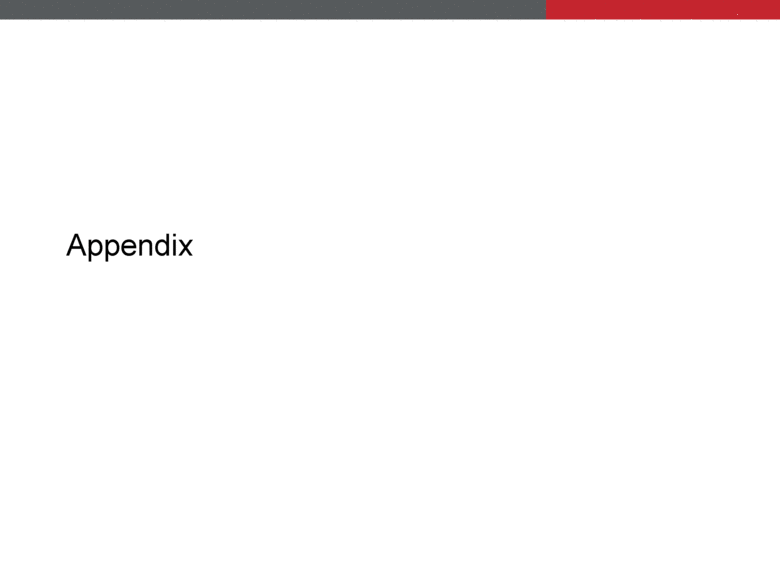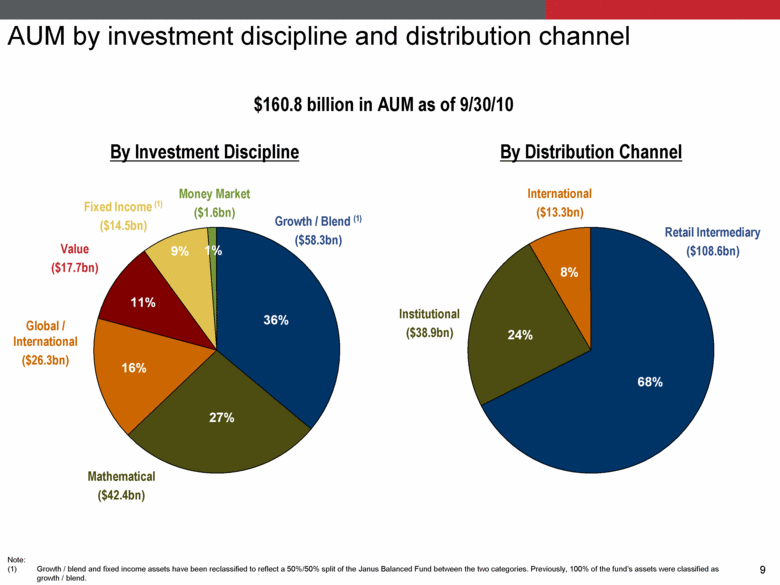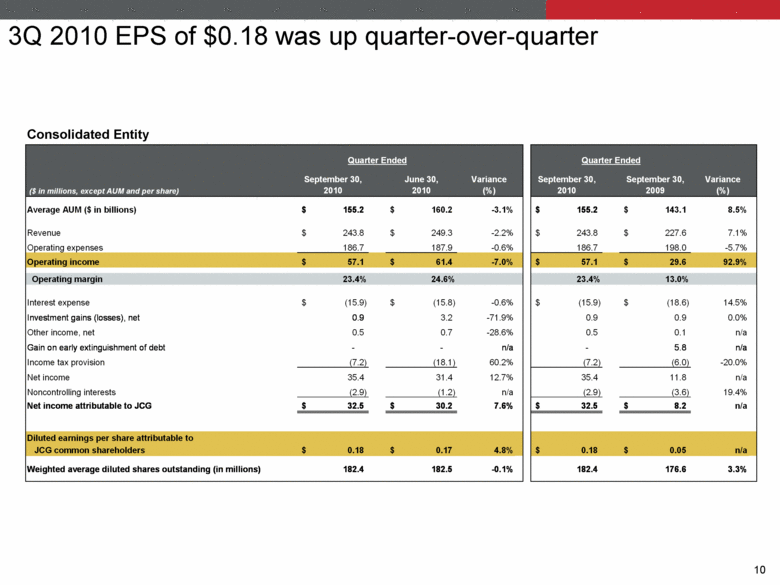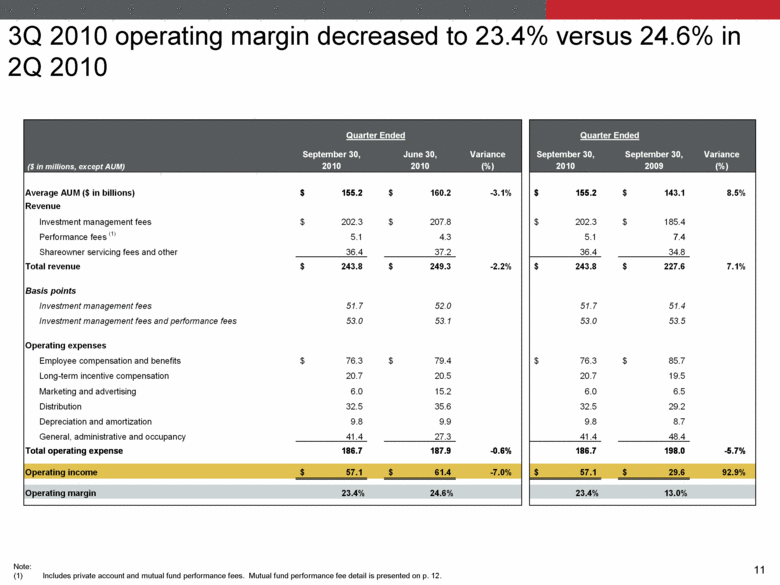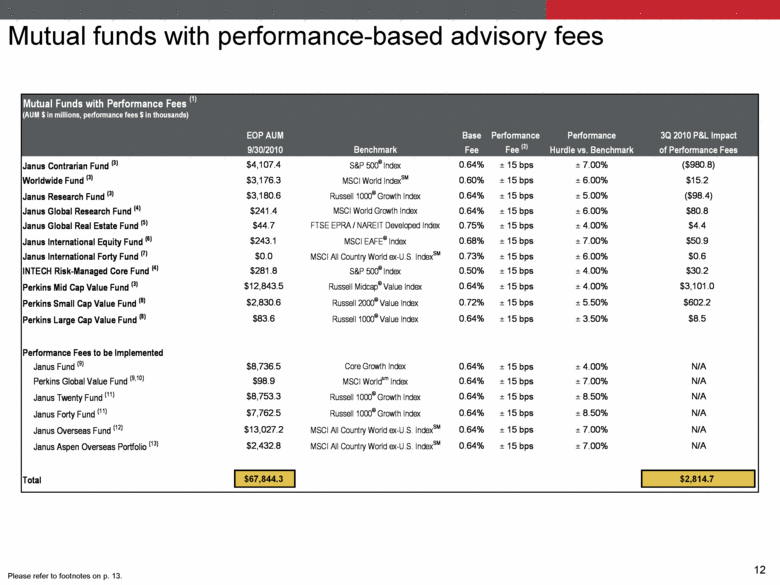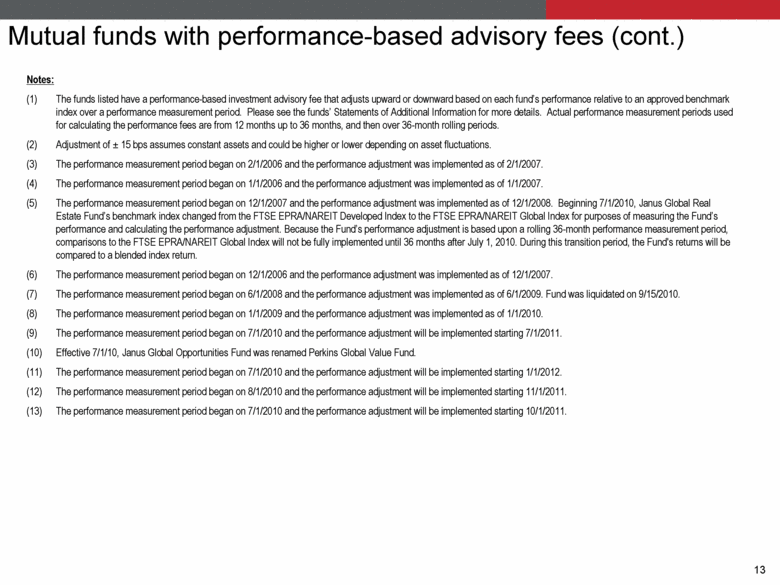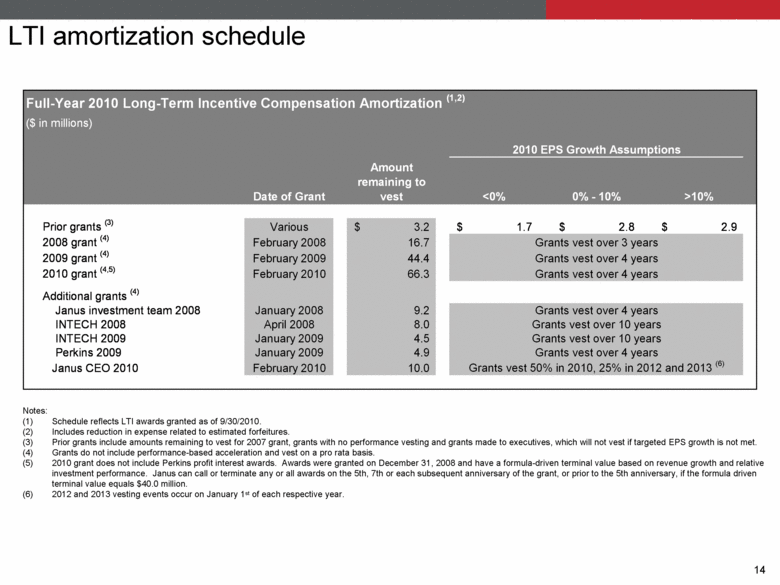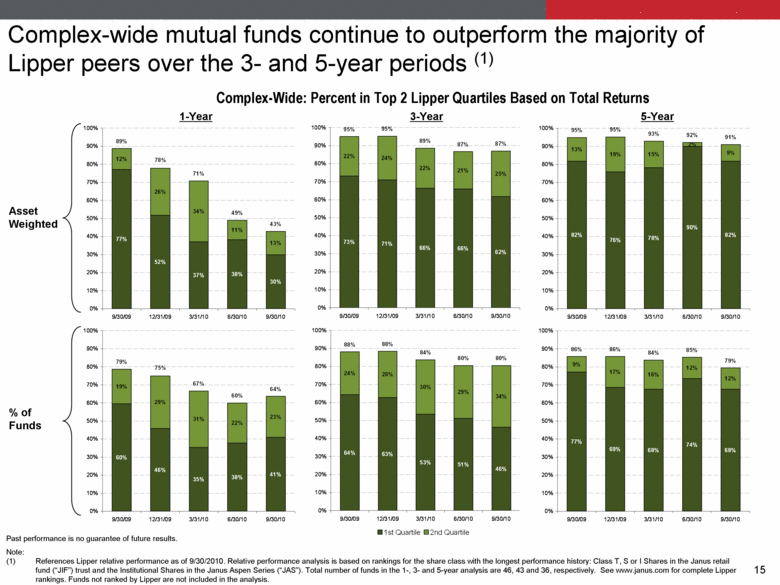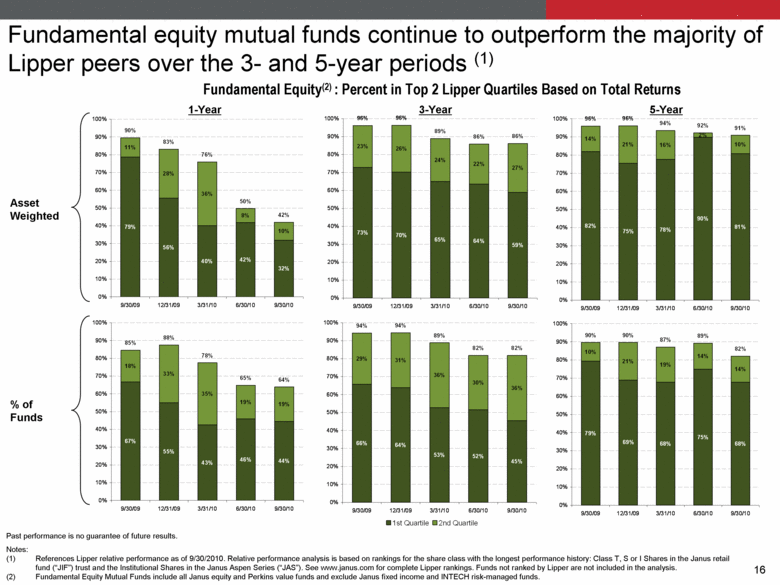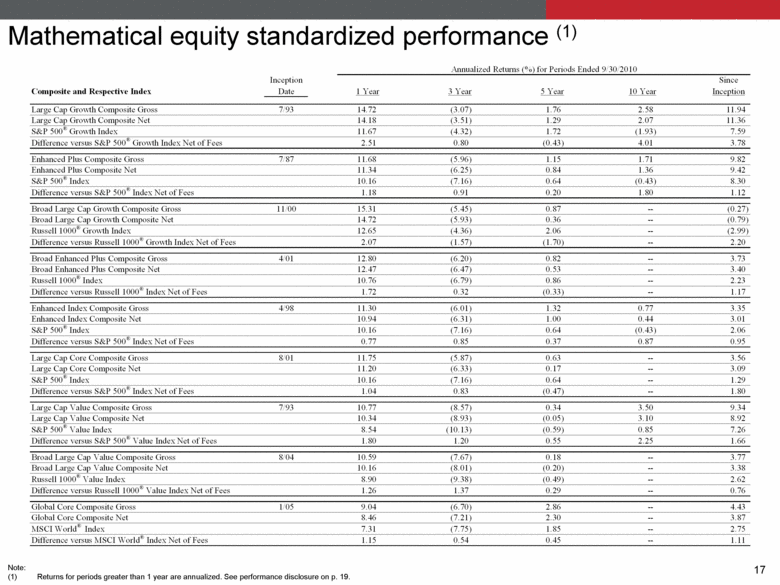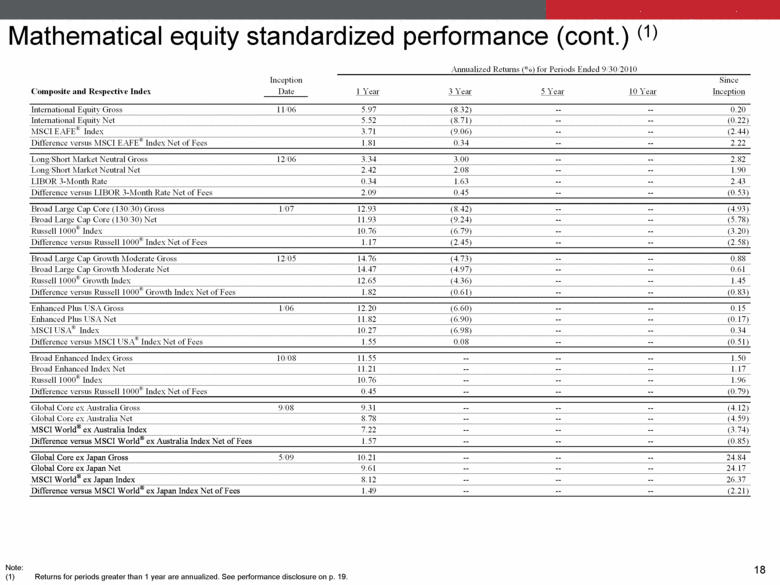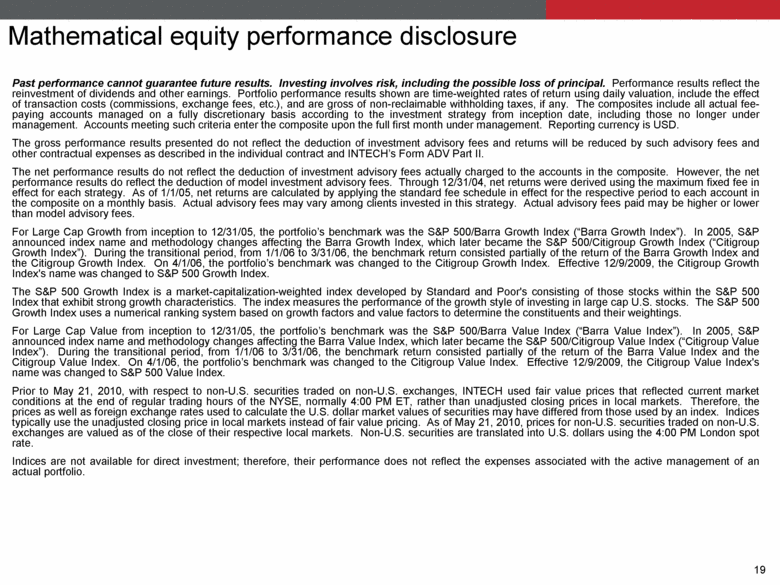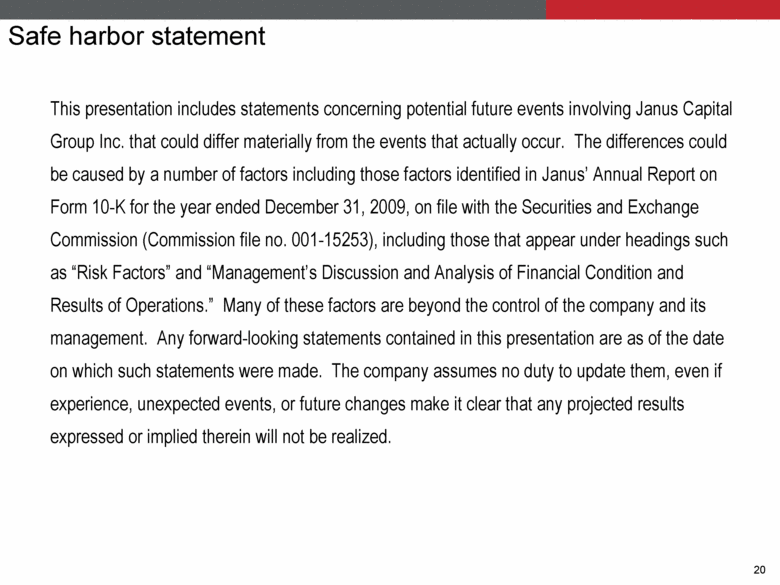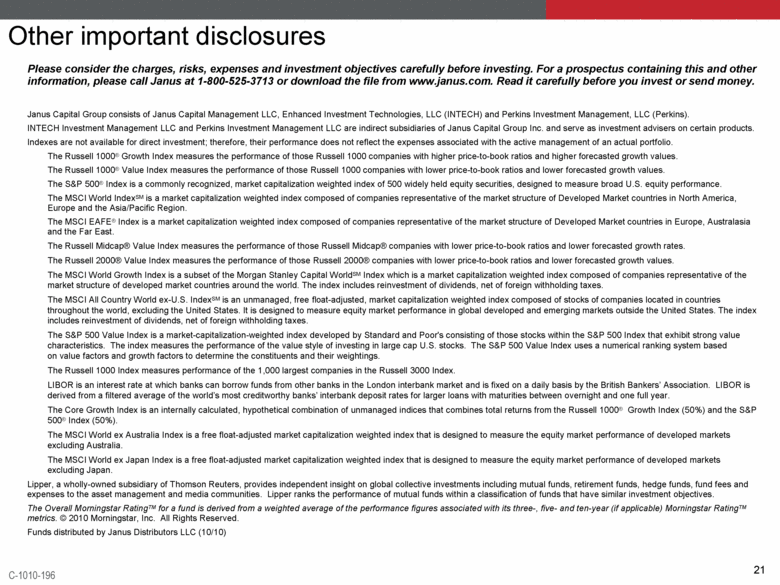Attached files
| file | filename |
|---|---|
| 8-K - 8-K - JANUS CAPITAL GROUP INC | a10-17263_38k.htm |
| EX-99.3 - EX-99.3 - JANUS CAPITAL GROUP INC | a10-17263_3ex99d3.htm |
| EX-99.1 - EX-99.1 - JANUS CAPITAL GROUP INC | a10-17263_3ex99d1.htm |
Exhibit 99.2
|
|
Third Quarter 2010 Earnings Presentation October 21, 2010 Dick Weil Chief Executive Officer Greg Frost Chief Financial Officer |
|
|
3Q 2010 EPS of $0.18 increased from $0.17 in 2Q 2010 and $0.05 in 3Q 2009 Janus’ 3Q 2010 total company long-term net flows were $(2.9) billion, as outflows in fundamental and mathematical equity were partially offset by inflows in fixed income Fundamental equity had net flows of $(1.8) billion in 3Q 2010 compared to $(1.1) billion in 2Q 2010, reflecting slowing sales and one significant client reallocation Improved performance in mathematical equity strategies has not yet translated into better flows; 3Q 2010 net flows declined to $(2.1) billion from $(1.5) billion in 2Q 2010 Fixed income continued to gain traction in 3Q 2010 with net flows of $1.0 billion, representing annualized organic growth of 32%, more than double the industry’s growth Janus Capital Group 3Q 2010 executive summary |
|
|
Long-term performance remains strong across the firm; however, key fundamental equity strategies are experiencing underperformance Performance in our mathematical equity strategies has significantly improved over the last year Outperformance continued in 3Q 2010 leading to 100% of strategies beating their respective benchmarks on a 1-year basis as of September 30, 2010, compared to 42% as of June 30, 2010 and 0% as of September 30, 2009 (1) Continuing to expand our fixed income franchise Global High Yield and Global Investment Grade strategies are scheduled to be launched in 4Q 2010 Despite slowing sales in 3Q 2010, year-to-date gross sales in the advisor channel are up 27% compared to the same period in 2009 Gaining momentum in the institutional channel with Janus-managed products Diversifying our product strategies with the launch of income-oriented and global offerings We are making progress in our global, institutional and fixed income efforts, but face strong industry headwinds Note: References relative performance net of fees as of 9/30/2010. See p. 17-19 for complete INTECH performance and disclosures. |
|
|
3Q 2010 Results Greg Frost Chief Financial Officer |
|
|
Notes: Long-term flows exclude money market flows. Annualized sales and redemption rates calculated as a percentage of beginning of period assets. Fundamental equity flows include all Janus equity and Perkins value flows and exclude Janus fixed income and INTECH risk-managed flows. Fundamental equity and fixed income long-term flows and assets have been reclassified for all time periods to reflect a 50%/50% split of the Janus Balanced Fund between the two categories. Previously, 100% of the fund’s flows and assets had been classified as fundamental equity. 3Q 2010 total company flows were negatively impacted by a slowdown in gross sales 26% 27% 24% 29% 21% Total Company Long-Term Flows (1) ($ in billions) Mathematical Equity Long-Term Flows (1) ($ in billions) Fundamental Equity Long-Term Flows (1,2,3) ($ in billions) Gross Redemptions Gross Sales Net Sales 28% 27% 29% 32% 29% Annualized Redemption Rate Annualized Gross Sales Rate Fixed Income Long-Term Flows (1,3) ($ in billions) 29% 26% 28% 28% 21% 25% 21% 22% 32% 29% Annualized Redemption Rate Annualized Gross Sales Rate 10% 19% 4% 18% 9% 33% 38% 41% 31% 29% Annualized Redemption Rate Annualized Gross Sales Rate 93% 84% 80% 83% 60% 33% 31% 37% 38% 29% Annualized Redemption Rate Annualized Gross Sales Rate $2.4 $1.9 $2.0 $1.9 $1.7 ($0.9) ($1.1) ($0.9) ($0.7) ($0.6) $1.0 $1.3 $1.1 $1.2 $1.1 ($4) ($2) $0 $2 $4 3Q09 4Q09 1Q10 2Q10 3Q10 $5.8 $6.1 $6.8 $7.4 $5.0 ($5.0) ($4.9) ($5.5) ($8.5) ($6.8) $0.8 $1.2 $1.3 ($1.1) ($1.8) ($20) ($10) $0 $10 $20 3Q09 4Q09 1Q10 2Q10 3Q10 $1.1 $2.2 $0.5 $0.9 $2.0 ($3.7) ($4.6) ($4.8) ($3.5) ($3.0) ($2.5) ($2.4) ($4.3) ($1.5) ($2.1) ($12) ($6) $0 $6 $12 3Q09 4Q09 1Q10 2Q10 3Q10 |
|
|
Over the 3- and 5-year periods, 86% and 91% of fundamental equity mutual fund assets are outperforming the majority of Lipper peers, respectively; 100% of fixed income mutual fund assets are outperforming the majority of Lipper peers over the same time periods (1,2) As a result of underperformance in key fundamental equity strategies, the percent of fundamental equity mutual fund assets in the top 2 Lipper quartiles on a 1-year basis fell to 42%, as of September 30, 2010, compared to 90% as of September 30, 2009 (1,2) 46% of fixed income mutual fund assets are outperforming the majority of Lipper peers over a 1-year total return basis (1,2) Performance in our mathematical equity strategies continued to improve 100%, 79% and 56% of strategies were beating their respective benchmarks, on a 1-, 3- and 5-year basis (3) 46% of complex-wide mutual funds had a 4- or 5-star Overall Morningstar Rating™ at September 30, 2010, based on risk-adjusted returns (2,4) Past performance is no guarantee of future results. Notes: References Lipper relative performance on an asset weighted, total return basis as of 9/30/2010. See p. 15-16 for percent of assets and funds in top 2 Lipper quartiles. Performance for fundamental equity includes all Janus equity and Perkins value funds and excludes Janus fixed income and INTECH risk-managed funds. Relative performance analysis is based on ratings and rankings for the share class with the longest performance history: Class T, S or I Shares in the Janus retail fund (“JIF”) trust and the Institutional Shares in the Janus Aspen Series (“JAS”). See www.janus.com for complete Lipper rankings and Morningstar ratings based on risk-adjusted returns. References relative performance net of fees as of 9/30/2010. See p. 17-19 for complete INTECH performance and disclosures. 41 funds were included in the analysis; Morningstar does not rank funds with less than a 3-year performance history. Long-term performance remains strong across the firm |
|
|
3Q 2010 EPS of $0.18 versus $0.17 in 2Q 2010 and $0.05 in 3Q 2009 3Q 2009 EPS included a net $0.10 per share charge as a result of legal settlements, severance and realized gains following the debt tender Assets Under Management (“AUM”) at September 30, 2010 of $160.8 billion increased 5.9% versus September 30, 2009 Average AUM of $155.2 billion and revenue of $243.8 million declined 3.1% and 2.2%, respectively, from 2Q 2010, and increased 8.5% and 7.1%, respectively, from 3Q 2009 3Q 2010 operating expenses of $186.7 million declined slightly from $187.9 million in 2Q 2010 3Q 2010 included a $13.6 million charge related to reimbursements to the funds for two significant fund administrative errors, while 2Q 2010 included $8.1 million of fund proxy costs As a result, operating margin in 3Q 2010 declined to 23.4% from 24.6% in 2Q 2010 3Q 2010 included a $9.0 million non-operating benefit following the reversal of income tax reserves 3Q 2010 financial overview |
|
|
Appendix |
|
|
Value ($17.7bn) Retail Intermediary ($108.6bn) $160.8 billion in AUM as of 9/30/10 By Investment Discipline By Distribution Channel Growth / Blend (1) ($58.3bn) Money Market ($1.6bn) Global / International ($26.3bn) Fixed Income (1) ($14.5bn) Mathematical ($42.4bn) Institutional ($38.9bn) International ($13.3bn) AUM by investment discipline and distribution channel Note: Growth / blend and fixed income assets have been reclassified to reflect a 50%/50% split of the Janus Balanced Fund between the two categories. Previously, 100% of the fund’s assets were classified as growth / blend. 24% 8% 68% 36% 1% 9% 11% 16% 27% |
|
|
Consolidated Entity 3Q 2010 EPS of $0.18 was up quarter-over-quarter September 30, June 30, Variance September 30, September 30, Variance ( $ in millions , except AUM and per share ) 2010 2010 (%) 2010 2009 (%) Average AUM ($ in billions) 155.2 $ 160.2 $ -3.1% 155.2 $ 143.1 $ 8.5% Revenue 243.8 $ 249.3 $ -2.2% 243.8 $ 227.6 $ 7.1% Operating expenses 186.7 187.9 -0.6% 186.7 198.0 -5.7% Operating income 57.1 $ 61.4 $ -7.0% 57.1 $ 29.6 $ 92.9% Operating margin 23.4% 24.6% 23.4% 13.0% Interest expense (15.9) $ (15.8) $ -0.6% (15.9) $ (18.6) $ 14.5% Investment gains (losses), net 0.9 3.2 -71.9% 0.9 0.9 0.0% Other income, net 0.5 0.7 -28.6% 0.5 0.1 n/a Gain on early extinguishment of debt - - n/a - 5.8 n/a Income tax provision (7.2) (18.1) 60.2% (7.2) (6.0) -20.0% Net income 35.4 31.4 12.7% 35.4 11.8 n/a Noncontrolling interests (2.9) (1.2) n/a (2.9) (3.6) 19.4% Net income attributable to JCG 32.5 $ 30.2 $ 7.6% 32.5 $ 8.2 $ n/a Diluted earnings per share attributable to JCG common shareholders 0.18 $ 0.17 $ 4.8% 0.18 $ 0.05 $ n/a Weighted average diluted shares outstanding (in millions) 182.4 182.5 -0.1% 182.4 176.6 3.3% Quarter Ended Quarter Ended |
|
|
Note: Includes private account and mutual fund performance fees. Mutual fund performance fee detail is presented on p. 12. 3Q 2010 operating margin decreased to 23.4% versus 24.6% in 2Q 2010 September 30, June 30, Variance September 30, September 30, Variance ($ in millions, except AUM) 2010 2010 (%) 2010 2009 (%) Average AUM ($ in billions) 155.2 $ 160.2 $ -3.1% 155.2 $ 143.1 $ 8.5% Revenue Investment management fees 202.3 $ 207.8 $ 202.3 $ 185.4 $ Performance fees (1) 5.1 4.3 5.1 7.4 Shareowner servicing fees and other 36.4 37.2 36.4 34.8 Total revenue 243.8 $ 249.3 $ -2.2% 243.8 $ 227.6 $ 7.1% Basis points Investment management fees 51.7 52.0 51.7 51.4 Investment management fees and performance fees 53.0 53.1 53.0 53.5 Operating expenses Employee compensation and benefits 76.3 $ 79.4 $ 76.3 $ 85.7 $ Long-term incentive compensation 20.7 20.5 20.7 19.5 Marketing and advertising 6.0 15.2 6.0 6.5 Distribution 32.5 35.6 32.5 29.2 Depreciation and amortization 9.8 9.9 9.8 8.7 General, administrative and occupancy 41.4 27.3 41.4 48.4 Total operating expense 186.7 187.9 -0.6% 186.7 198.0 -5.7% Operating income 57.1 $ 61.4 $ -7.0% 57.1 $ 29.6 $ 92.9% Operating margin 23.4% 24.6% 23.4% 13.0% Quarter Ended Quarter Ended |
|
|
Mutual funds with performance-based advisory fees Please refer to footnotes on p. 13. Mutual Funds with Performance Fees (1) (AUM $ in millions, performance fees $ in thousands) EOP AUM Base Performance Performance 3Q 2010 P&L Impact 9/30/2010 Benchmark Fee Fee (2) Hurdle vs. Benchmark of Performance Fees Janus Contrarian Fund (3) $4,107.4 S&P 500 ® Index 0.64% ± 15 bps ± 7.00% ($980.8) Worldwide Fund (3) $3,176.3 MSCI World Index SM 0.60% ± 15 bps ± 6.00% $15.2 Janus Research Fund (3) $3,180.6 Russell 1000 ® Growth Index 0.64% ± 15 bps ± 5.00% ($98.4) Janus Global Research Fund (4) $241.4 MSCI World Growth Index 0.64% ± 15 bps ± 6.00% $80.8 Janus Global Real Estate Fund (5) $44.7 FTSE EPRA / NAREIT Developed Index 0.75% ± 15 bps ± 4.00% $4.4 Janus International Equity Fund (6) $243.1 MSCI EAFE ® Index 0.68% ± 15 bps ± 7.00% $50.9 Janus International Forty Fund (7) $0.0 MSCI All Country World ex-U.S. Index SM 0.73% ± 15 bps ± 6.00% $0.6 INTECH Risk-Managed Core Fund (4) $281.8 S&P 500 ® Index 0.50% ± 15 bps ± 4.00% $30.2 Perkins Mid Cap Value Fund (3) $12,843.5 Russell Midcap ® Value Index 0.64% ± 15 bps ± 4.00% $3,101.0 Perkins Small Cap Value Fund (8) $2,830.6 Russell 2000 ® Value Index 0.72% ± 15 bps ± 5.50% $602.2 Perkins Large Cap Value Fund (8) $83.6 Russell 1000 ® Value Index 0.64% ± 15 bps ± 3.50% $8.5 Performance Fees to be Implemented Janus Fund (9) $8,736.5 Core Growth Index 0.64% ± 15 bps ± 4.00% N/A Perkins Global Value Fund (9,10) $98.9 MSCI World sm Index 0.64% ± 15 bps ± 7.00% N/A Janus Twenty Fund (11) $8,753.3 Russell 1000 ® Growth Index 0.64% ± 15 bps ± 8.50% N/A Janus Forty Fund (11) $7,762.5 Russell 1000 ® Growth Index 0.64% ± 15 bps ± 8.50% N/A Janus Overseas Fund (12) $13,027.2 MSCI All Country World ex-U.S. Index SM 0.64% ± 15 bps ± 7.00% N/A Janus Aspen Overseas Portfolio (13) $2,432.8 MSCI All Country World ex-U.S. Index SM 0.64% ± 15 bps ± 7.00% N/A Total $67,844.3 $2,814.7 |
|
|
Notes: The funds listed have a performance-based investment advisory fee that adjusts upward or downward based on each fund’s performance relative to an approved benchmark index over a performance measurement period. Please see the funds’ Statements of Additional Information for more details. Actual performance measurement periods used for calculating the performance fees are from 12 months up to 36 months, and then over 36-month rolling periods. Adjustment of ± 15 bps assumes constant assets and could be higher or lower depending on asset fluctuations. The performance measurement period began on 2/1/2006 and the performance adjustment was implemented as of 2/1/2007. The performance measurement period began on 1/1/2006 and the performance adjustment was implemented as of 1/1/2007. The performance measurement period began on 12/1/2007 and the performance adjustment was implemented as of 12/1/2008. Beginning 7/1/2010, Janus Global Real Estate Fund’s benchmark index changed from the FTSE EPRA/NAREIT Developed Index to the FTSE EPRA/NAREIT Global Index for purposes of measuring the Fund’s performance and calculating the performance adjustment. Because the Fund’s performance adjustment is based upon a rolling 36-month performance measurement period, comparisons to the FTSE EPRA/NAREIT Global Index will not be fully implemented until 36 months after July 1, 2010. During this transition period, the Fund's returns will be compared to a blended index return. The performance measurement period began on 12/1/2006 and the performance adjustment was implemented as of 12/1/2007. The performance measurement period began on 6/1/2008 and the performance adjustment was implemented as of 6/1/2009. Fund was liquidated on 9/15/2010. The performance measurement period began on 1/1/2009 and the performance adjustment was implemented as of 1/1/2010. The performance measurement period began on 7/1/2010 and the performance adjustment will be implemented starting 7/1/2011. Effective 7/1/10, Janus Global Opportunities Fund was renamed Perkins Global Value Fund. The performance measurement period began on 7/1/2010 and the performance adjustment will be implemented starting 1/1/2012. The performance measurement period began on 8/1/2010 and the performance adjustment will be implemented starting 11/1/2011. The performance measurement period began on 7/1/2010 and the performance adjustment will be implemented starting 10/1/2011. Mutual funds with performance-based advisory fees (cont.) |
|
|
Notes: Schedule reflects LTI awards granted as of 9/30/2010. Includes reduction in expense related to estimated forfeitures. Prior grants include amounts remaining to vest for 2007 grant, grants with no performance vesting and grants made to executives, which will not vest if targeted EPS growth is not met. Grants do not include performance-based acceleration and vest on a pro rata basis. 2010 grant does not include Perkins profit interest awards. Awards were granted on December 31, 2008 and have a formula-driven terminal value based on revenue growth and relative investment performance. Janus can call or terminate any or all awards on the 5th, 7th or each subsequent anniversary of the grant, or prior to the 5th anniversary, if the formula driven terminal value equals $40.0 million. 2012 and 2013 vesting events occur on January 1st of each respective year. LTI amortization schedule Full-Year 2010 Long-Term Incentive Compensation Amortization (1,2) ($ in millions) Date of Grant Amount remaining to vest <0% 0% - 10% >10% Prior grants (3) Various 3.2 $ 1.7 $ 2.8 $ 2.9 $ 2008 grant (4) February 2008 16.7 2009 grant (4) February 2009 44.4 2010 grant (4,5) February 2010 66.3 Additional grants (4) Janus investment team 2008 January 2008 9.2 INTECH 2008 April 2008 8.0 INTECH 2009 January 2009 4.5 Perkins 2009 January 2009 4.9 Janus CEO 2010 February 2010 10.0 Grants vest 50% in 2010, 25% in 2012 and 2013 (6) Grants vest over 10 years Grants vest over 4 years Grants vest over 3 years Grants vest over 4 years Grants vest over 4 years Grants vest over 10 years Grants vest over 4 years 2010 EPS Growth Assumptions |
|
|
Complex-wide mutual funds continue to outperform the majority of Lipper peers over the 3- and 5-year periods (1) Complex-Wide: Percent in Top 2 Lipper Quartiles Based on Total Returns 1-Year 3-Year 5-Year Asset Weighted % of Funds Past performance is no guarantee of future results. Note: References Lipper relative performance as of 9/30/2010. Relative performance analysis is based on rankings for the share class with the longest performance history: Class T, S or I Shares in the Janus retail fund (“JIF”) trust and the Institutional Shares in the Janus Aspen Series (“JAS”). Total number of funds in the 1-, 3- and 5-year analysis are 46, 43 and 36, respectively. See www.janus.com for complete Lipper rankings. Funds not ranked by Lipper are not included in the analysis. 82% 76% 78% 90% 82% 13% 19% 15% 2% 9% 95% 92% 95% 93% 91% 0% 10% 20% 30% 40% 50% 60% 70% 80% 90% 100% 9/30/09 12/31/09 3/31/10 6/30/10 9/30/10 Percent of Janus Investment Funds . 1st Quartile 2nd Quartile 77% 52% 37% 38% 30% 12% 26% 34% 11% 13% 43% 71% 89% 78% 49% 0% 10% 20% 30% 40% 50% 60% 70% 80% 90% 100% 9/30/09 12/31/09 3/31/10 6/30/10 9/30/10 Percent of Janus Investment Funds . 1st Quartile 2nd Quartile 46% 61% 63% 61% 48% 24% 27% 31% 33% 39% 88% 94% 88% 94% 71% 0% 10% 20% 30% 40% 50% 60% 70% 80% 90% 100% 3/31/09 6/30/09 9/30/09 12/31/09 3/31/10 Percent of Janus Managed Equity JIF Funds . 1st Quartile 2nd Quartile 60% 46% 35% 38% 41% 19% 29% 31% 22% 23% 64% 67% 79% 75% 60% 0% 10% 20% 30% 40% 50% 60% 70% 80% 90% 100% 9/30/09 12/31/09 3/31/10 6/30/10 9/30/10 Percent of Janus Investment Funds . 1st Quartile 2nd Quartile 77% 69% 68% 74% 68% 9% 17% 16% 12% 12% 86% 85% 86% 84% 79% 0% 10% 20% 30% 40% 50% 60% 70% 80% 90% 100% 9/30/09 12/31/09 3/31/10 6/30/10 9/30/10 Percent of Janus Investment Funds . 1st Quartile 2nd Quartile 73% 71% 66% 66% 62% 22% 24% 22% 21% 25% 95% 87% 87% 89% 95% 0% 10% 20% 30% 40% 50% 60% 70% 80% 90% 100% 9/30/09 12/31/09 3/31/10 6/30/10 9/30/10 Percent of Janus Investment Funds . 1st Quartile 2nd Quartile 64% 63% 53% 51% 46% 24% 26% 30% 29% 34% 88% 80% 80% 84% 88% 0% 10% 20% 30% 40% 50% 60% 70% 80% 90% 100% 9/30/09 12/31/09 3/31/10 6/30/10 9/30/10 Percent of Janus Investment Funds . 1st Quartile 2nd Quartile |
|
|
Fundamental Equity(2) : Percent in Top 2 Lipper Quartiles Based on Total Returns 1-Year 3-Year Asset Weighted % of Funds 5-Year Past performance is no guarantee of future results. Notes: References Lipper relative performance as of 9/30/2010. Relative performance analysis is based on rankings for the share class with the longest performance history: Class T, S or I Shares in the Janus retail fund (“JIF”) trust and the Institutional Shares in the Janus Aspen Series (“JAS”). See www.janus.com for complete Lipper rankings. Funds not ranked by Lipper are not included in the analysis. Fundamental Equity Mutual Funds include all Janus equity and Perkins value funds and exclude Janus fixed income and INTECH risk-managed funds. Fundamental equity mutual funds continue to outperform the majority of Lipper peers over the 3- and 5-year periods (1) 46% 61% 63% 61% 48% 24% 27% 31% 33% 39% 88% 94% 88% 94% 71% 0% 10% 20% 30% 40% 50% 60% 70% 80% 90% 100% 3/31/09 6/30/09 9/30/09 12/31/09 3/31/10 Percent of Janus Managed Equity JIF Funds . 1st Quartile 2nd Quartile 66% 64% 53% 52% 45% 29% 31% 36% 30% 36% 94% 82% 82% 89% 94% 0% 10% 20% 30% 40% 50% 60% 70% 80% 90% 100% 9/30/09 12/31/09 3/31/10 6/30/10 9/30/10 Percent of Janus Managed Equity JIF Funds . 1st Quartile 2nd Quartile 79% 56% 40% 42% 32% 11% 28% 36% 8% 10% 83% 50% 90% 76% 42% 0% 10% 20% 30% 40% 50% 60% 70% 80% 90% 100% 9/30/09 12/31/09 3/31/10 6/30/10 9/30/10 Percent of Janus Managed Equity JIF Funds . 1st Quartile 2nd Quartile 78% 90% 81% 14% 21% 16% 2% 10% 82% 75% 96% 92% 91% 94% 96% 0% 10% 20% 30% 40% 50% 60% 70% 80% 90% 100% 9/30/09 12/31/09 3/31/10 6/30/10 9/30/10 Percent of Janus Managed Equity JIF Funds . 1st Quartile 2nd Quartile 67% 55% 43% 46% 44% 18% 33% 35% 19% 19% 88% 65% 85% 78% 64% 0% 10% 20% 30% 40% 50% 60% 70% 80% 90% 100% 9/30/09 12/31/09 3/31/10 6/30/10 9/30/10 Percent of Janus Managed Equity JIF Funds . 1st Quartile 2nd Quartile 73% 70% 65% 64% 59% 23% 26% 24% 22% 27% 96% 86% 86% 89% 96% 0% 10% 20% 30% 40% 50% 60% 70% 80% 90% 100% 9/30/09 12/31/09 3/31/10 6/30/10 9/30/10 Percent of Janus Managed Equity JIF Funds . 1st Quartile 2nd Quartile |
|
|
Mathematical equity standardized performance (1) Note: Returns for periods greater than 1 year are annualized. See performance disclosure on p. 19. Inception Since Composite and Respective Index Date 1 Year 3 Year 5 Year 10 Year Inception Large Cap Growth Composite Gross 7/93 14.72 (3.07) 1.76 2.58 11.94 Large Cap Growth Composite Net 14.18 (3.51) 1.29 2.07 11.36 S&P 500 ® Growth Index 11.67 (4.32) 1.72 (1.93) 7.59 Difference versus S&P 500 ® Growth Index Net of Fees 2.51 0.80 (0.43) 4.01 3.78 Enhanced Plus Composite Gross 7/87 11.68 (5.96) 1.15 1.71 9.82 Enhanced Plus Composite Net 11.34 (6.25) 0.84 1.36 9.42 S&P 500 ® Index 10.16 (7.16) 0.64 (0.43) 8.30 Difference versus S&P 500 ® Index Net of Fees 1.18 0.91 0.20 1.80 1.12 Broad Large Cap Growth Composite Gross 11/00 15.31 (5.45) 0.87 -- (0.27) Broad Large Cap Growth Composite Net 14.72 (5.93) 0.36 -- (0.79) Russell 1000 ® Growth Index 12.65 (4.36) 2.06 -- (2.99) Difference versus Russell 1000 ® Growth Index Net of Fees 2.07 (1.57) (1.70) -- 2.20 Broad Enhanced Plus Composite Gross 4/01 12.80 (6.20) 0.82 -- 3.73 Broad Enhanced Plus Composite Net 12.47 (6.47) 0.53 -- 3.40 Russell 1000 ® Index 10.76 (6.79) 0.86 -- 2.23 Difference versus Russell 1000 ® Index Net of Fees 1.72 0.32 (0.33) -- 1.17 Enhanced Index Composite Gross 4/98 11.30 (6.01) 1.32 0.77 3.35 Enhanced Index Composite Net 10.94 (6.31) 1.00 0.44 3.01 S&P 500 ® Index 10.16 (7.16) 0.64 (0.43) 2.06 Difference versus S&P 500 ® Index Net of Fees 0.77 0.85 0.37 0.87 0.95 Large Cap Core Composite Gross 8/01 11.75 (5.87) 0.63 -- 3.56 Large Cap Core Composite Net 11.20 (6.33) 0.17 -- 3.09 S&P 500 ® Index 10.16 (7.16) 0.64 -- 1.29 Difference versus S&P 500 ® Index Net of Fees 1.04 0.83 (0.47) -- 1.80 Large Cap Value Composite Gross 7/93 10.77 (8.57) 0.34 3.50 9.34 Large Cap Value Composite Net 10.34 (8.93) (0.05) 3.10 8.92 S&P 500 ® Value Index 8.54 (10.13) (0.59) 0.85 7.26 Difference versus S&P 500 ® Value Index Net of Fees 1.80 1.20 0.55 2.25 1.66 Broad Large Cap Value Composite Gross 8/04 10.59 (7.67) 0.18 -- 3.77 Broad Large Cap Value Composite Net 10.16 (8.01) (0.20) -- 3.38 Russell 1000 ® Value Index 8.90 (9.38) (0.49) -- 2.62 Difference versus Russell 1000 ® Value Index Net of Fees 1.26 1.37 0.29 -- 0.76 Global Core Composite Gross 1/05 9.04 (6.70) 2.86 -- 4.43 Global Core Composite Net 8.46 (7.21) 2.30 -- 3.87 MSCI World ® Index 7.31 (7.75) 1.85 -- 2.75 Difference versus MSCI World ® Index Net of Fees 1.15 0.54 0.45 -- 1.11 Annualized Returns (%) for Periods Ended 9/30/2010 |
|
|
Note: Returns for periods greater than 1 year are annualized. See performance disclosure on p. 19. Mathematical equity standardized performance (cont.) (1) Inception Since Composite and Respective Index Date 1 Year 3 Year 5 Year 10 Year Inception International Equity Gross 11/06 5.97 (8.32) -- -- 0.20 International Equity Net 5.52 (8.71) -- -- (0.22) MSCI EAFE ® Index 3.71 (9.06) -- -- (2.44) Difference versus MSCI EAFE ® Index Net of Fees 1.81 0.34 -- -- 2.22 Long/Short Market Neutral Gross 12/06 3.34 3.00 -- -- 2.82 Long/Short Market Neutral Net 2.42 2.08 -- -- 1.90 LIBOR 3-Month Rate 0.34 1.63 -- -- 2.43 Difference versus LIBOR 3-Month Rate Net of Fees 2.09 0.45 -- -- (0.53) Broad Large Cap Core (130/30) Gross 1/07 12.93 (8.42) -- -- (4.93) Broad Large Cap Core (130/30) Net 11.93 (9.24) -- -- (5.78) Russell 1000 ® Index 10.76 (6.79) -- -- (3.20) Difference versus Russell 1000 ® Index Net of Fees 1.17 (2.45) -- -- (2.58) Broad Large Cap Growth Moderate Gross 12/05 14.76 (4.73) -- -- 0.88 Broad Large Cap Growth Moderate Net 14.47 (4.97) -- -- 0.61 Russell 1000 ® Growth Index 12.65 (4.36) -- -- 1.45 Difference versus Russell 1000 ® Growth Index Net of Fees 1.82 (0.61) -- -- (0.83) Enhanced Plus USA Gross 1/06 12.20 (6.60) -- -- 0.15 Enhanced Plus USA Net 11.82 (6.90) -- -- (0.17) MSCI USA ® Index 10.27 (6.98) -- -- 0.34 Difference versus MSCI USA ® Index Net of Fees 1.55 0.08 -- -- (0.51) Broad Enhanced Index Gross 10/08 11.55 -- -- -- 1.50 Broad Enhanced Index Net 11.21 -- -- -- 1.17 Russell 1000 ® Index 10.76 -- -- -- 1.96 Difference versus Russell 1000 ® Index Net of Fees 0.45 -- -- -- (0.79) Global Core ex Australia Gross 9/08 9.31 -- -- -- (4.12) Global Core ex Australia Net 8.78 -- -- -- (4.59) MSCI World ® ex Australia Index 7.22 -- -- -- (3.74) Difference versus MSCI World ® ex Australia Index Net of Fees 1.57 -- -- -- (0.85) Global Core ex Japan Gross 5/09 10.21 -- -- -- 24.84 Global Core ex Japan Net 9.61 -- -- -- 24.17 MSCI World ® ex Japan Index 8.12 -- -- -- 26.37 Difference versus MSCI World ® ex Japan Index Net of Fees 1.49 -- -- -- (2.21) Annualized Returns (%) for Periods Ended 9/30/2010 |
|
|
Past performance cannot guarantee future results. Investing involves risk, including the possible loss of principal. Performance results reflect the reinvestment of dividends and other earnings. Portfolio performance results shown are time-weighted rates of return using daily valuation, include the effect of transaction costs (commissions, exchange fees, etc.), and are gross of non-reclaimable withholding taxes, if any. The composites include all actual fee-paying accounts managed on a fully discretionary basis according to the investment strategy from inception date, including those no longer under management. Accounts meeting such criteria enter the composite upon the full first month under management. Reporting currency is USD. The gross performance results presented do not reflect the deduction of investment advisory fees and returns will be reduced by such advisory fees and other contractual expenses as described in the individual contract and INTECH’s Form ADV Part II. The net performance results do not reflect the deduction of investment advisory fees actually charged to the accounts in the composite. However, the net performance results do reflect the deduction of model investment advisory fees. Through 12/31/04, net returns were derived using the maximum fixed fee in effect for each strategy. As of 1/1/05, net returns are calculated by applying the standard fee schedule in effect for the respective period to each account in the composite on a monthly basis. Actual advisory fees may vary among clients invested in this strategy. Actual advisory fees paid may be higher or lower than model advisory fees. For Large Cap Growth from inception to 12/31/05, the portfolio’s benchmark was the S&P 500/Barra Growth Index (“Barra Growth Index”). In 2005, S&P announced index name and methodology changes affecting the Barra Growth Index, which later became the S&P 500/Citigroup Growth Index (“Citigroup Growth Index”). During the transitional period, from 1/1/06 to 3/31/06, the benchmark return consisted partially of the return of the Barra Growth Index and the Citigroup Growth Index. On 4/1/06, the portfolio’s benchmark was changed to the Citigroup Growth Index. Effective 12/9/2009, the Citigroup Growth Index's name was changed to S&P 500 Growth Index. The S&P 500 Growth Index is a market-capitalization-weighted index developed by Standard and Poor's consisting of those stocks within the S&P 500 Index that exhibit strong growth characteristics. The index measures the performance of the growth style of investing in large cap U.S. stocks. The S&P 500 Growth Index uses a numerical ranking system based on growth factors and value factors to determine the constituents and their weightings. For Large Cap Value from inception to 12/31/05, the portfolio’s benchmark was the S&P 500/Barra Value Index (“Barra Value Index”). In 2005, S&P announced index name and methodology changes affecting the Barra Value Index, which later became the S&P 500/Citigroup Value Index (“Citigroup Value Index”). During the transitional period, from 1/1/06 to 3/31/06, the benchmark return consisted partially of the return of the Barra Value Index and the Citigroup Value Index. On 4/1/06, the portfolio’s benchmark was changed to the Citigroup Value Index. Effective 12/9/2009, the Citigroup Value Index's name was changed to S&P 500 Value Index. Prior to May 21, 2010, with respect to non-U.S. securities traded on non-U.S. exchanges, INTECH used fair value prices that reflected current market conditions at the end of regular trading hours of the NYSE, normally 4:00 PM ET, rather than unadjusted closing prices in local markets. Therefore, the prices as well as foreign exchange rates used to calculate the U.S. dollar market values of securities may have differed from those used by an index. Indices typically use the unadjusted closing price in local markets instead of fair value pricing. As of May 21, 2010, prices for non-U.S. securities traded on non-U.S. exchanges are valued as of the close of their respective local markets. Non-U.S. securities are translated into U.S. dollars using the 4:00 PM London spot rate. Indices are not available for direct investment; therefore, their performance does not reflect the expenses associated with the active management of an actual portfolio. Mathematical equity performance disclosure |
|
|
Safe harbor statement This presentation includes statements concerning potential future events involving Janus Capital Group Inc. that could differ materially from the events that actually occur. The differences could be caused by a number of factors including those factors identified in Janus’ Annual Report on Form 10-K for the year ended December 31, 2009, on file with the Securities and Exchange Commission (Commission file no. 001-15253), including those that appear under headings such as “Risk Factors” and “Management’s Discussion and Analysis of Financial Condition and Results of Operations.” Many of these factors are beyond the control of the company and its management. Any forward-looking statements contained in this presentation are as of the date on which such statements were made. The company assumes no duty to update them, even if experience, unexpected events, or future changes make it clear that any projected results expressed or implied therein will not be realized. |
|
|
Please consider the charges, risks, expenses and investment objectives carefully before investing. For a prospectus containing this and other information, please call Janus at 1-800-525-3713 or download the file from www.janus.com. Read it carefully before you invest or send money. Janus Capital Group consists of Janus Capital Management LLC, Enhanced Investment Technologies, LLC (INTECH) and Perkins Investment Management, LLC (Perkins). INTECH Investment Management LLC and Perkins Investment Management LLC are indirect subsidiaries of Janus Capital Group Inc. and serve as investment advisers on certain products. Indexes are not available for direct investment; therefore, their performance does not reflect the expenses associated with the active management of an actual portfolio. The Russell 1000® Growth Index measures the performance of those Russell 1000 companies with higher price-to-book ratios and higher forecasted growth values. The Russell 1000® Value Index measures the performance of those Russell 1000 companies with lower price-to-book ratios and lower forecasted growth values. The S&P 500® Index is a commonly recognized, market capitalization weighted index of 500 widely held equity securities, designed to measure broad U.S. equity performance. The MSCI World IndexSM is a market capitalization weighted index composed of companies representative of the market structure of Developed Market countries in North America, Europe and the Asia/Pacific Region. The MSCI EAFE® Index is a market capitalization weighted index composed of companies representative of the market structure of Developed Market countries in Europe, Australasia and the Far East. The Russell Midcap® Value Index measures the performance of those Russell Midcap® companies with lower price-to-book ratios and lower forecasted growth rates. The Russell 2000® Value Index measures the performance of those Russell 2000® companies with lower price-to-book ratios and lower forecasted growth values. The MSCI World Growth Index is a subset of the Morgan Stanley Capital WorldSM Index which is a market capitalization weighted index composed of companies representative of the market structure of developed market countries around the world. The index includes reinvestment of dividends, net of foreign withholding taxes. The MSCI All Country World ex-U.S. IndexSM is an unmanaged, free float-adjusted, market capitalization weighted index composed of stocks of companies located in countries throughout the world, excluding the United States. It is designed to measure equity market performance in global developed and emerging markets outside the United States. The index includes reinvestment of dividends, net of foreign withholding taxes. The S&P 500 Value Index is a market-capitalization-weighted index developed by Standard and Poor's consisting of those stocks within the S&P 500 Index that exhibit strong value characteristics. The index measures the performance of the value style of investing in large cap U.S. stocks. The S&P 500 Value Index uses a numerical ranking system based on value factors and growth factors to determine the constituents and their weightings. The Russell 1000 Index measures performance of the 1,000 largest companies in the Russell 3000 Index. LIBOR is an interest rate at which banks can borrow funds from other banks in the London interbank market and is fixed on a daily basis by the British Bankers’ Association. LIBOR is derived from a filtered average of the world’s most creditworthy banks’ interbank deposit rates for larger loans with maturities between overnight and one full year. The Core Growth Index is an internally calculated, hypothetical combination of unmanaged indices that combines total returns from the Russell 1000® Growth Index (50%) and the S&P 500® Index (50%). The MSCI World ex Australia Index is a free float-adjusted market capitalization weighted index that is designed to measure the equity market performance of developed markets excluding Australia. The MSCI World ex Japan Index is a free float-adjusted market capitalization weighted index that is designed to measure the equity market performance of developed markets excluding Japan. Lipper, a wholly-owned subsidiary of Thomson Reuters, provides independent insight on global collective investments including mutual funds, retirement funds, hedge funds, fund fees and expenses to the asset management and media communities. Lipper ranks the performance of mutual funds within a classification of funds that have similar investment objectives. The Overall Morningstar RatingTM for a fund is derived from a weighted average of the performance figures associated with its three-, five- and ten-year (if applicable) Morningstar RatingTM metrics. © 2010 Morningstar, Inc. All Rights Reserved. Funds distributed by Janus Distributors LLC (10/10) Other important disclosures C-1010-196 |

